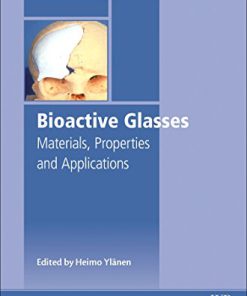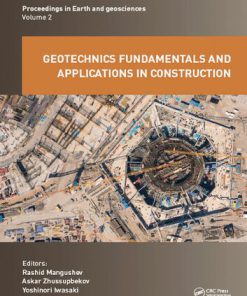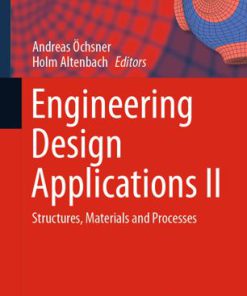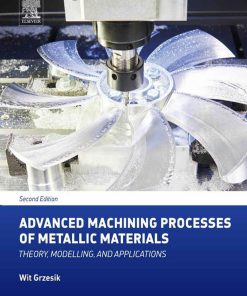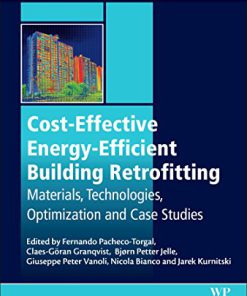Nanotechnology in eco efficient construction materials processes and applications 2nd Edition by Pacheco Torgal, Diamanti, Nazari, Granqvist, Pruma, Amirkhanian ISBN 9780081026427 0081026420
$50.00 Original price was: $50.00.$25.00Current price is: $25.00.
Nanotechnology in eco efficient construction materials processes and applications 2nd Edition by Pacheco Torgal, Diamanti, Nazari, Granqvist, Pruma, Amirkhanian – Ebook PDF Instant Download/Delivery: 9780081026427 ,0081026420
Full download Nanotechnology in eco efficient construction materials processes and applications 2nd Edition after payment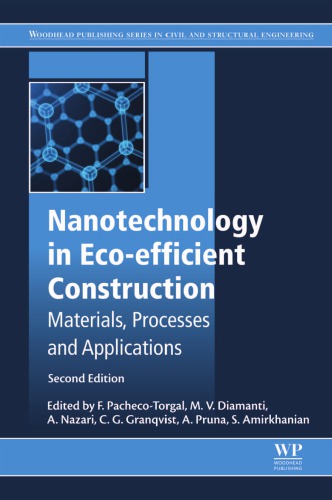
Product details:
ISBN 10: 0081026420
ISBN 13: 9780081026427
Author: Pacheco Torgal, Diamanti, Nazari, Granqvist, Pruma, Amirkhanian
Covering the latest technologies, Nanotechnology in eco-efficient construction provides an authoritative guide to the role of nanotechnology in the development of eco-efficient construction materials and sustainable construction. The book contains a special focus on applications concerning concrete and cement, as nanotechnology is driving significant development in concrete technologies. The new edition has 14 new chapters, including 3 new parts: Mortars and concrete related applications; Applications for pavements and other structural materials; and Toxicity, safety handling and environmental impacts.
Civil engineers requiring an understanding of eco-efficient construction materials, as well as researchers and architects within any field of nanotechnology, eco-efficient materials or the construction industry will find this updated reference to be highly valuable.
- Addresses issues such as toxicity and LCA aspects
- New chapters covering safety handling on occupational exposure of nanoparticles and the assessment of personal exposure to airborne nanomaterials
- Discusses the effects of adding nano-particles on the durability and on the properties of geopolymers
Nanotechnology in eco efficient construction materials processes and applications 2nd Edition Table of contents:
1 – Introduction to nanotechnology in eco-efficient construction
1.1 Recent nanotechnology advancements and limitations
1.2 Nanotech-based materials for eco-efficient construction
1.3 Outline of the Book
References
One – Mortars and concrete related applications
2 – Influence of nanoparticles on the strength of ultra-high performance concrete
2.1 Introduction
2.2 Types of nanomaterials in cement-based composites
2.3 Role of nanoparticles in ultra-high performance concrete (UHPC)
2.4 UHPC curing regimes
2.4.1 Curing in water
2.4.2 Steam-curing regime
2.4.3 Autoclaving
2.5 Strength of UHPC
2.5.1 Compressive strength
2.5.2 Flexural strength
2.5.3 Tensile splitting strength
2.6 Production problems and recommendations for practical application
Acknowledgments
References
3 – The effect of nanoparticles on the self-healing capacity of high performance concrete
3.1 Introduction
3.2 Self-healing systems based on nanoparticles used in cementitious materials
3.2.1 Nonencapsulated self-healing systems
3.2.2 Encapsulated self-healing systems
3.3 Influence of self-healing systems in the characteristics of HPC
3.3.1 Modifications in the microstructural properties
3.3.2 Modifications in the physico-mechanical performance
3.3.3 Modifications in the self-healing capacity
3.4 Durability of self-healing HPC under aggressive environments
3.5 Future trends
References
4 – The impact of graphene oxide on cementitious composites
4.1 Introduction
4.2 Graphene materials
4.3 Graphene oxide
4.3.1 GO synthesis
4.3.2 Structure of GO
4.3.3 Hygroscopic nature of GO
4.4 Effects of GO incorporation into cementitious composites
4.4.1 Effects on mechanical properties
4.4.2 The influence of GO on durability
4.5 Some structural applications of GO/cement composites in repairing of reinforced concrete
4.6 Summary of the chapter
Acknowledgment
References
5 – Application of nanomaterials in alkali-activated materials
5.1 Introduction
5.2 Nanotechnology in alkali-activated materials
5.3 Effects of nanosilica on alkali-activated materials
5.4 Effect of nanoclay on alkali-activated materials
5.5 Effect of nano-TiO2 on alkali-activated materials
5.6 Effects of carbon nanotube on alkali-activated materials
5.7 Conclusions and recommendations
References
6 – Effects of nanofibers on properties of geopolymer composites
6.1 Introduction
6.2 Design of experiments approach
6.2.1 Main effects
6.2.2 Interaction effects
6.3 Experimental
6.3.1 Materials of the investigation
6.3.2 Sample preparation technique
6.3.2.1 Mixing of nanomaterials
6.3.2.2 Processing and curing of nanoreinforced sample
6.3.3 Factorial design
6.3.3.1 Fractional design
6.3.4 Test matrix
6.3.5 Fracture toughness measurement technique
6.4 Results and discussions
6.4.1 Effect of nanofillers on KIC of the MEYEB geopolymer
6.4.2 Statistical analysis of KIC data
6.5 Summary
References
7 – Nanoindentation for evaluation of properties of cement hydration products
7.1 Introduction
7.2 Cement hydration
7.3 Hydration mechanism in cement–fly ash system
7.4 Nanoindentation technique
7.4.1 What is nanoindentation?
7.4.2 Determination of material properties
7.4.3 Unique advantages, assumptions, and limitations
7.4.4 Nanoindentation for cementitious materials
7.4.5 Factors influencing the results of nanoindentation
7.5 Properties of cement hydration products—experimental investigations
7.6 Results and discussion
7.6.1 Cement paste (CP) specimens
7.6.1.1 Cement paste with fly ash (CPFA) specimens
7.6.1.2 Way forward
Acknowledgments
References
Two – Applications for pavements and other infrastructure materials
8 – Performance of asphalt mixture with nanoparticles
8.1 Introduction
8.2 Types of nanoparticles modified asphalt mixture
8.2.1 Nanoclay modified asphalt
8.2.2 Nanosilica modified asphalt cement
8.2.3 Carbon nanotubes modified asphalt cement
8.3 Laboratory techniques for preparation of nanoparticles modified asphalt mixtures
8.4 Materials and experimental design
8.4.1 Materials
8.4.2 Modified asphalt binders preparation
8.4.3 The design of aggregates
8.4.4 Determination of volumetric properties of asphalt mixtures
8.5 Advantages and disadvantages of nanoparticles in the modification of asphalt mixtures
8.6 Characteristic and performance evaluation of nanoparticles modified asphalt mixtures
8.6.1 Influence of nanoparticles on resilient modulus of asphalt mixtures
8.6.2 Effect of nanoparticles on dynamic creep
8.6.3 Impact of nanoparticles on the rutting distress
8.6.4 Influence of nanoparticles on moisture susceptibility
8.7 Durability of modified asphalt mixtures
8.8 Challenges of nanoparticles modification
8.9 Conclusion
Acknowledgments
References
9 – Nanomodified asphalt mixture with enhanced performance
9.1 Introduction and background
9.2 Classification of nanomaterials applied for asphalt binder modification
9.2.1 Application of nanomineral materials on asphalt mixture modification
9.2.2 Application of carbon nanotubes and exfoliated graphite nanoplatelets (xGNP) on asphalt mixtur
9.2.3 Examination on mixture uniformity
9.3 Enhanced performance of the nanomodified asphalt mixture
9.3.1 Property enhancement with the nanomineral materials modification
9.3.1.1 Enhancement on mechanical properties of asphalt binder due to nanomineral modification
9.3.1.2 Improvement on the fire reactions for the asphalt mixture
9.3.2 Property enhanced with the nanocarbon materials modified asphalt mixture
9.3.2.1 Change on mechanical properties of asphalt binder due to nanocarbon modification
9.3.2.2 Modification on the electrical, thermal, and optical performance of the nanomodified asphalt
9.3.3 Bonding strength examination between the mineral aggregate and nanomaterials modified asphalt
9.4 Conclusions and current achievement and knowledge gaps on the application of nanomodified asphal
9.4.1 Summarization on the application of nanomaterials in asphalt mixture
9.4.2 Current knowledge gap on the study of nanomaterial modified asphalt mixture
References
10 – Effects of graphene oxide on asphalt binders
10.1 Introduction
10.2 Materials and experiments
10.2.1 Materials
10.2.1.1 Asphalt binders
10.2.1.2 Graphene oxide
10.2.2 Characterization of GO
10.2.2.1 Fourier transform infrared spectroscopy test
10.2.2.2 X-ray diffraction test
10.2.2.3 Thermogravimetric test
10.2.3 Preparation of GO MA
10.2.4 Asphalt properties tests
10.2.4.1 Separation test of GO MA
10.2.4.2 Gas chromatography–mass spectrometry test
10.2.4.3 Physical properties tests
10.2.4.4 Dynamic shear rheometer test
10.2.4.5 Bending beams rheometer test
10.3 Results and discussions
10.3.1 Interaction between GO and asphalt
10.3.1.1 Preparation process
10.3.1.2 Gas chromatography–mass spectrometry (GC–MS) analysis
10.3.1.3 FTIR analysis of GO MA
10.3.1.4 XRD analysis of GO MA
10.3.2 GO effect on asphalt properties
10.3.2.1 Storage stability
10.3.2.2 Physical properties
10.3.2.3 Rheological properties
10.3.2.3.1 High temperature sweep
10.3.2.3.2 Low temperature sweep
10.3.2.4 BBR test
10.3.2.5 Thermal properties
10.4 Aging characteristics of modified binders
10.5 Conclusions
References
11 – NanoComposites for structural health monitoring
11.1 Introduction
11.2 Types of nanocomposites for structural health monitoring
11.2.1 Nanocementitious composites
11.2.2 Nanopolymer composites
11.3 Fabrication and signal measurement of nanocomposites
11.3.1 Dispersion of nanofillers and mix design
11.3.2 Measurement sensing signals of nanocomposites
11.4 Sensing properties of nanocomposites
11.4.1 Sensing properties of nanocementitious composites under loadings
11.4.2 Sensing properties of nanopolymer composites under loadings
11.5 Sensing mechanisms of nanocomposites
11.6 Application in structural health monitoring
11.6.1 Monitoring for structural parameters
11.6.2 Monitoring for traffic parameters
11.7 Conclusions and future trends
References
Further reading
12 – Concrete with nanomaterials and fibers for self-monitoring of strain and cracking subjected to
12.1 Introduction
12.2 Experimental investigations
12.2.1 Materials and mixture design
12.2.2 Samples and set-up description
12.2.3 Test methods
12.3 Influence of conductive admixtures on the mechanical and electrical properties of concrete beam
12.3.1 Influence of conductive admixtures on the workability
12.3.2 Influence of conductive admixtures on the compression and flexural behavior
12.3.2.1 Effect of conductive materials on the compressive and flexural strength
12.3.2.2 Effects of conductive materials on the flexural toughness
12.3.3 Influence of conductive admixtures on the relationship between strain and FCR (self-monitorin
12.3.4 Influence of conductive admixtures on the relationship between FCR and flexural load-bearing
12.3.5 Influence of conductive admixtures on the relationship between FCR and crack opening displace
12.4 Conclusion
References
13 – Icephobic nanocoatings for infrastructure protection
13.1 Introduction
13.2 Ice protection strategies
13.3 Types of infrastructure applications for ice protection
13.4 Basics of icephobic nanocoatings
13.5 Nanocoatings with organic fillers
13.6 Nanocoatings with inorganic fillers
13.6.1 Silica-based
13.6.2 Carbon-based
13.6.3 Metallic and metallic oxide-based
13.7 Hybrid nanocoatings
13.8 Functionalized nanomaterials
13.9 Analysis
13.10 Future trends
13.11 Conclusion
13.12 Sources of further information and advice
References
14 – Self-healing nanocoatings for protection against steel corrosion
14.1 Introduction
14.2 Corrosion and nanocoatings: ways of protection
14.3 Compendium of nanocoatings
14.3.1 Inorganic nanocoatings
14.3.2 Organic nanocoatings
14.3.3 Manufacturing methods
14.4 Advanced nanocoatings: introduction of self-healing properties
14.4.1 Polymeric coatings
14.4.2 Silane coatings
14.5 Implementation of nanocoatings
14.5.1 Patents review
14.5.2 Commercial applications summary
14.6 Future trends
References
15 – Nanocoatings for protection against steel corrosion
15.1 Introduction
15.2 Nanofillers for anticorrosion coatings
15.3 Metallic nanofillers
15.4 Metal oxide nanofillers
15.5 Polymeric nanofillers
15.6 Carbon-based nanofillers
15.6.1 Carbon nanotubes
15.6.2 Nanodiamonds
15.6.3 Graphene-based nanomaterials
15.7 Conclusions and future perspectives
Acknowledgments
References
16 – Fire retardant nanocoating for wood protection
16.1 Introduction
16.2 Requirements for fire safety of wooden building structures
16.3 Types of fire retardant treatment of wooden structures
16.3.1 Intumescent coatings
16.3.2 Fire retardant impregnations
16.4 Nanotechnologies for fire protection of wood
16.4.1 Layered aluminosilicates (nanoclays)
16.4.2 Nanooxides and inorganic flame retardants
16.4.3 Nanosilica sol and silicon compounds
16.4.4 Nanostructured carbon materials
16.5 Mechanisms of fire-protective action of nanocompounds
16.5.1 Chemical interactions
16.5.2 Physical factors
16.5.3 Barrier and shielding effects
16.6 Increasing of the durability and biological stability of wood
16.7 Perspectives and recommendations
References
Three – Applications for building energy efficiency
17 – Aerogel-enhanced insulation for building applications
17.1 Introduction
17.2 Aerogel synthesis and market
17.2.1 Aerogel synthesis
17.2.2 Aerogel market
17.3 Aerogel properties
17.4 Aerogel-enhanced opaque systems
17.4.1 Aerogel-enhanced mortars and concretes
17.4.2 Aerogel-enhanced Plasters
17.4.3 Aerogel-enhanced Blankets
17.5 Conclusions
References
Further reading
18 – Nano aerogel windows and glazing units for buildings’ energy efficiency
18.1 Introduction
18.2 Advanced glazing technologies
18.2.1 Solar windows
18.2.2 Switchable or chromogenic glazing
18.2.3 Evacuated glazing
18.2.4 Insulation-filled glazing
18.3 Aerogel and its properties
18.4 Aerogel manufacturing
18.4.1 Gelation
18.4.2 Purification and aging
18.4.3 Drying
18.5 Aerogel windows and glazing units
18.5.1 Applications/Case studies
18.5.1.1 Buchwiesen School Sports Hall, Zurich
18.5.1.2 Commercial building in Hong Kong
18.5.1.3 Office building in Central London
18.5.1.4 Educational building at Worcester Polytechnic Institute, USA
18.5.1.5 School building in London
18.5.1.6 The Monetary Times building, Toronto, Canada
18.5.1.7 Office building, London, UK
18.5.2 Research progress
18.5.3 Commercial status
18.5.4 Challenges ahead
18.6 Conclusion
References
19 – Smart perovskite-based technologies for building integration: a cross-disciplinary approach
19.1 Introduction
19.2 Perovskite-based photovoltaics (PVs)
19.2.1 Device architectures and performances of semitransparent PVs
19.2.2 Highly transparent perovskite-based PVs
19.2.3 Building integration of perovskite-based solar cells: effects on energy balance and visual co
19.3 The evolution of multifunctional chromogenics
19.4 Perovskite-based photovoltachromics (PVCDs)
19.4.1 Multifunctional devices: design and figures of merit
19.4.2 Building integration of chromogenic devices
19.5 Forthcoming perspectives for multifunctional windows
References
20 – Electrochromic glazing for energy efficient buildings
20.1 Introduction
20.2 On the energy saving potential and other assets
20.3 Operating principles and materials
20.3.1 Generic device design
20.3.2 The key role of nanostructure
20.3.3 Optical properties
20.3.4 Some comments on mixed electrochromic oxides
20.4 Flexible electrochromic foils: a case study
20.5 Towards superior electrochromic glazing: some recent results
20.5.1 Improved durability and rejuvenation of electrochromic thin films by electrochemical treatmen
20.5.2 Electrolyte functionalization
20.6 Conclusions and perspectives
References
21 – VO2-based thermochromic materials and applications: flexible foils and coated glass for energy
21.1 Introduction
21.2 VO2 nanoparticles and thermochromic flexible foils
21.2.1 Preparation of VO2 nanoparticles
21.2.2 Composite nanostructures of VO2 (core shelling, hybridization, etc.)
21.2.3 Products of VO2-based thermochromic flexible foils
21.3 VO2 thin films and coated glass with multilayer design and multifunctional structures
21.3.1 Fabrication methods of VO2 thin films
21.3.2 Structure and optical design of VO2-based multilayer films
21.3.3 Multifunctional structures
21.3.4 Scaling up and challenges
21.4 Future trends
21.5 Sources of further information and advice
Acknowledgments
References
Four – Photocatalytic applications
22 – Photocatalytic performance of mortars with nanoparticles exposed to the urban environment
22.1 Introduction: historical hints
22.2 The most common photocatalyst: titanium dioxide
22.3 Other photocatalysts in cement-based materials
22.3.1 ZnO
22.3.2 Hybrid oxides
22.4 Photocatalytic mortars and concretes
22.4.1 Degradation of pollutants
22.4.1.1 Dye degradation
22.4.1.2 Air purification
22.4.1.3 In service studies and pilot tests
22.4.2 Self-cleaning and antivegetative properties
22.4.2.1 Self-cleaning
22.4.2.2 Antivegetative properties
22.4.3 Interactions with mortar constituents
22.4.3.1 Interactions between TiO2 and binders
22.4.3.2 Changes of mortar properties
22.4.3.3 Interaction with pigments
22.4.4 Aging of the material
22.4.4.1 Carbonation
22.4.4.2 Soiling and solar reflectance
22.5 Existing standards on photocatalytic materials
References
23 – Multifunctional photocatalytic coatings for construction materials
23.1 Introduction
23.2 Composition of photocatalytic coatings
23.2.1 Titanium dioxide
23.2.2 Other semiconductors, composites, and mixtures
23.2.3 Additives
23.2.4 Substrates
23.3 Coatings: application procedures and characteristics
23.3.1 Coating techniques
23.3.2 Thickness and roughness
23.3.3 Adhesion and durability
23.4 Techniques for physico-chemical characterization
23.4.1 Determination of main photocatalyst characteristics
23.4.2 Analysis of coating surface properties
23.5 Photocatalytic performance
23.5.1 NOx abatement
23.5.2 VOCs abatement
23.6 Challenges and future perspectives
References
24 – Self-cleaning efficiency of nanoparticles applied on facade bricks
24.1 Introduction
24.2 Degradation of building facades by natural and artificial agents
24.3 Self-cleaning facades
24.3.1 Superhydrophobic additives
24.3.2 Photocatalytic and superhydrophilic additives
24.3.2.1 Methods of self-cleaning facade preparation
Spray coating
Sputtering
Sol–gel dip-coating
Microwave (MW) irradiation method
Preparation of photoactive superhydrophobic facades
24.3.2.2 Determination of self-cleaning properties
24.3.2.3 Assessment of durability
24.3.3 Combined (superhydrophobic and photocatalytic) additives
24.4 Future trends
References
25 – Nanotreatments to inhibit microalgal fouling on building stone surfaces
25.1 Introduction
25.2 Biodegradation of building surfaces: nanomaterials to inhibit microbial colonization
25.3 Nanostructured titanium dioxide to limit algal contamination
25.3.1 Experimental setup
25.3.2 Performance assessment of TiO2-nanocoatings
25.3.2.1 Overview
25.3.2.2 Microscopic morphology
25.3.2.3 Optical performance
25.3.2.4 Biocidal performances
25.4 Effectiveness of TiO2-based nanoproducts to inhibit algal growth
25.5 Outlook and future research pathways
Acknowledgments
References
26 – Self-cleaning cool paints
26.1 Introduction
26.2 Self-cleaning coating system
26.3 Field measurements
26.3.1 Measurement site and result
26.3.2 Solar reflectance
26.3.3 Surface temperature
26.3.4 Influence of solar altitude, dirt, and coating deterioration on solar reflectance
26.3.4.1 Influence of solar altitude
26.3.4.2 Influence of dirt and coating deterioration
26.3.4.3 Prediction of solar reflectance change in the other area
26.4 Cooling load calculation
26.4.1 Outline of calculation
26.4.2 Configuration of building materials
26.4.3 Cooling load
26.4.4 Cost-saving
26.5 Field observation of cooling energy savings
26.5.1 Outline of measurement
26.5.2 Method of evaluating cooling energy savings
26.5.3 Examination of cooling energy savings
26.6 Summary
Acknowledgments
References
27 – Photocatalytic water treatment
27.1 Introduction
27.2 Advanced oxidation processes and semiconductor photocatalysis
27.2.1 TiO2 photocatalysis
27.2.2 Photocatalytic ozonation
27.2.3 Photocatalytic reactors based on TiO2
27.2.3.1 Thin film reactors
27.2.3.2 Optical fiber reactors
27.2.3.3 Packed bed reactors
27.2.3.4 Fluidized bed reactors
27.2.3.5 Monolith reactors
27.3 Immobilization and characterization of titanium dioxide thin films
27.3.1 Immobilization
27.3.2 Increasing the photocatalytic activity of immobilized photocatalysts
27.3.2.1 Increasing porosity
27.3.2.2 Decreasing particle size
27.3.3 Increasing photocatalytic activity under visible light illumination
27.4 Degradation of model contaminants
27.4.1 Disinfection
27.4.2 Degradation of dyes
27.4.3 Degradation of surfactants
27.4.4 Degradation of organic micropollutants
27.4.4.1 Pesticides and herbicides
27.4.4.2 Pharmaceuticals and personal care products
27.4.4.3 Phenol
27.4.5 Simulated and real wastewater
27.5 Conclusion and further perspectives
References
Five – Toxicity, safety handling and environmental impacts
28 – Toxicity of nanoparticles
28.1 Introduction
28.2 The “nano” scale
28.3 Nanoparticle physicochemical characteristic–dependent toxicity
28.4 Nanoparticle size–dependent toxicity
28.4.1 Nanoparticle size in the respiratory system
28.4.2 Nanoparticle size–dependent cellular uptake
28.4.3 Mechanisms of nanoparticle toxicity inside cells
28.5 Nanoparticle aggregation and shape dependent toxicity
28.6 Nanoparticle composition–dependent toxicity
28.7 Inhalation of nanoparticles
28.7.1 Occupational nanoparticle inhalation and toxicity
28.7.2 Nanoparticles detected in human tissues
28.7.3 Toxicity and carcinogenicity of nanoparticles in humans and animals
28.8 Nanoparticle biodistribution and persistence
28.9 Ingestion of nanoparticles
28.10 Outline of nanoparticle toxicity
28.11 Concluding remarks
References
29 – Risk management: controlling occupational exposure to nanoparticles in construction
29.1 Background
29.2 Risk management
29.2.1 Bow-tie, a model for accident and exposure processes
29.3 Occupational risk assessment
29.3.1 Tiered approach
29.3.2 Qualitative risk assessment
29.3.3 Control banding
29.3.3.1 Control banding methods—CB Nanotool
29.3.3.2 CB methods—Stoffenmanager Nano 1.0
29.3.3.3 Control banding methods—other methods
29.4 Risk control
29.4.1 Risk management in construction
29.4.2 Design analysis
29.4.3 Systematic design analysis approach
29.5 Construction processes and nanomaterials
29.6 Final remarks
References
30 – Measurement techniques of exposure to nanomaterials in workplaces
30.1 Introduction
30.2 Measurement strategy
30.2.1 Definitions for airborne engineered nanomaterials and NOAA
30.2.2 Techniques and parameters for exposure measurements
30.2.3 Harmonized strategy for NOAA exposure measurements in the workplace
30.2.3.1 Information gathering
30.2.3.2 Basic exposure assessment
30.2.3.3 Expert exposure assessment
30.2.4 Major issues to conduct a cost-effective measurement
30.2.4.1 Background characterization
30.2.4.2 Laboratory simulations and dustiness tests
30.3 Devices and measurement techniques in the workplaces
30.3.1 Real-time instruments
30.3.2 Integration time instruments
30.3.3 Off-line analysis
30.3.3.1 Inductively coupled plasma
30.3.3.2 Gas chromatography and liquid chromatography
30.3.3.3 Electron microscopy techniques
Scanning electron microscope
Transmission electron microscope
30.3.3.4 Complementary instruments
30.4 Conclusions
References
31 – Life-cycle assessment of engineered nanomaterials
31.1 Introduction
31.2 Potential release of and exposure to engineered nanomaterials during different life cycle stage
31.2.1 Release and exposure during the production and manufacturing stages
31.2.2 Release and exposure during the use-phase
31.2.3 Release and exposure during the end-of-life stage
31.2.4 Other relevant aspects in the impact pathway
31.3 Life cycle assessment standard practice and specificities of the application to ENMs
31.3.1 Goal and scope definition
31.3.2 Life cycle inventory analysis
31.3.3 Life cycle impact assessment
31.3.4 Interpretation
31.4 State of the art and limitations of LCA studies applied to engineered nanomaterials
31.4.1 Classification of studies
31.4.2 Brief review of studies
31.4.3 Limitations of the applications of LCA to ENMs: methodological and data gaps
31.4.4 Sources of uncertainty, assumptions and limitations of life cycle assessment in the context o
31.5 Recent developments to fill gaps, and potential for integrating life cycle assessment and risk
31.6 Conclusions
References
Index
People also search for Nanotechnology in eco efficient construction materials processes and applications 2nd Edition:
what is nanotechnology in construction
examples of eco-efficiency
benefits of nanotechnology in environment
what is environmental nanotechnology
Tags:
Pacheco Torgal,Diamanti,Nazari,Granqvist,Pruma,Amirkhanian,Nanotechnology,eco efficient,construction,materials,applications
You may also like…
Housekeeping & Leisure - Interior Design & Decoration
Cookbooks
Earth Sciences - Mining
Construction Materials: Geology, Production and Applications 1st Edition Manuel Bustillo Revuelta
Engineering - Mechanical Engineering & Dynamics
Engineering
Advanced machining processes of metallic materials : theory, modelling and applications Wit Grzesik
Science (General)





